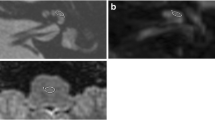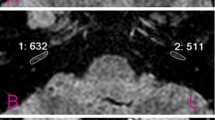Abstract
Purpose
The aim of this work is to study otosclerotic patients by 3D-FLAIR (fluid attenuated inversion recovery) sequence magnetic resonance imaging (MRI) with and without Gadolinium administration (−/+ Gd), to understand whether there is a direct relationship between radiological findings at 3D FLAIR MRI sequences and some clinical features of otosclerosis, such as the presence and entity of sensorineural involvement, duration of disease, patient gender, and other factors.
Methods
38 patients affected by different stages of unilateral or bilateral otosclerosis underwent 3D FLAIR MRI+/− Gd. 11 subjects with normal hearing, previously submitted to 3T MRI for other minor diseases, unrelated with otosclerosis, had been retrospectively enrolled as control group.
Results
We found significant correlations between 3D FLAIR MRI findings and some clinical features of otosclerosis, such as severity of cochlear damage (in terms of entity of sensorineural loss) and duration of disease. These findings indicate that at 3D-FLAIR MRI different patterns may depend on the level of blood labyrinth barrier damage in the cochlea, and be related to different stages of cochlear involvement in otosclerotic patients.
Conclusions
We believe that our findings may contribute in understanding the pathogenesis of cochlear damage in otosclerosis and may have further prognostic value. Our results led us to consider the possible use of 3D-FLAIR sequences in monitoring the effectiveness of any medical therapy of otosclerosis and in selecting the patients eligible for treatment.



Similar content being viewed by others
References
Berrettini S, Ravecca F, Volterrani D, Neri E, Forli F (2010) Imaging evaluation in otosclerosis: single photon emission computed tomography and computed tomography. Ann Otol Rhinol Laryngol 119(4):215–224
Berrettini S, Seccia V, Fortunato S et al (2013) Analysis of the 3-dimensional fluid-attenuated inversion-recovery (3D-FLAIR) sequence in idiopathic sudden sensorineural hearing loss. JAMA Otolaryngol Head Neck Surg 139(5):456–464
Canapicchi R, De Marchi D, Lombardo F, Fortunato S, De Cori S, Montanaro D, Berrettini S (2010) Sudden sensorineural hearing loss. MR Imaging Neuroradiol J 23(2):161–171
de Oliveira Vicente A, Chandrasekhar SS, Yamashita HK, Cruz OL, Barros FA, Penido NO (2015) Magnetic resonance imaging in the evaluation of clinical treatment of otospongiosis: a pilot study. Otolaryngol Head Neck Surg 152(6):1119–1126
Floc’h JL, Tan W, Telang RS, Vlajkovic SM, Nuttall A, Rooney WD, Pontré B, Thorne PR (2014) Markers of cochlear inflammation using MRI. J Magn Reson Imaging 39(1):150–161
Goh JP, Chan LL, Tan TY (2002) MRI of cochlear otosclerosis. Br J Radiol 75(894):502–505
Lee TC, Aviv RI, Chen JM, Nedzelski JM, Fox AJ, Symons SP (2009) CT grading of otosclerosis. AJNR Am J Neuroradiol 30(7):1435–1439
Lolov SR, Encheva VI, Kyurkchiev SD, Edrev GE, Kehayov IR (2001) Antimeasles immunoglobulin G in sera of patients with otosclerosis is lower than that in healthy people. Otol Neurotol 22(6):766–770
Lombardo F, De Cori S, Aghakhanyan G et al (2016) 3D-Flair sequence at 3T in cochlear otosclerosis. Eur Radiol 26(10):3744–3751
Markou K, Goudakos J (2009) An overview of the etiology of otosclerosis. Eur Arch Otol Rhinol Laryngol 266(1):25–35
Naganawa S, Kawai H, Taoka T, Suzuki K, Iwano S, Satake H, Sone M, Ikeda M (2016) Cochlear lymph fluid signal increase in patients with otosclerosis after intravenous administration of gadodiamide. Magn Reson Med Sci 15(3):308–315
Stankovic KM, McKenna MJ (2006) Current research in otosclerosis. Curr Opin Otolaryngol Head Neck Surg 14(5):347–351
Sugiura M, Naganawa S, Sone M, Yoshida T, Nakashima T (2008) Three-dimensional fluid-attenuated inversion recovery magnetic resonance imaging findings in a patient with cochlear otosclerosis. Auris Nasus Larynx 35(2):269–272
Sugiura M, Naganawa S, Teranishi M, Nakashima T (2006) Three-dimensional fluid-attenuated inversion recovery magnetic resonance imaging findings in patients with sudden sensorineural hearing loss. Laryngoscope 116(8):1451–1454
Swartz JD, Mandell DW, Berman SE, Wolfson RJ, Marlowe FI, Popky GL (1985) Cochlear otosclerosis (otospongiosis): CT analysis with audiometric correlation. Radiology 155:147–150
Swartz JD, Mandell DW, Wolfson RJ et al (1985) Fenestral and cochlear otosclerosis: computed tomographic evaluation. Am J Otol 6:476–481
Valvassori GE (1993) Imaging of otosclerosis. Otorinolaryngol Clin N Am 26(3):359–371
Virk JS, Singh A, Lingam RK (2013) The role of imaging in the diagnosis and management of otosclerosis. Otol Neurotol 34(7):55–60
Author information
Authors and Affiliations
Corresponding author
Ethics declarations
Conflict of interest
The authors declare that they have no conflict of interest.
Ethical approval
For this type of study formal consent is not required. This article does not contain any studies with animals performed by any of the authors.
Informed consent
Informed consent was obtained from all individual participants included in the study.
Rights and permissions
About this article
Cite this article
Berrettini, S., Lombardo, F., Bruschini, L. et al. 3D fluid attenuated inversion recovery (FLAIR) magnetic resonance imaging at different stages of otosclerosis. Eur Arch Otorhinolaryngol 275, 2643–2652 (2018). https://doi.org/10.1007/s00405-018-5093-2
Received:
Accepted:
Published:
Issue Date:
DOI: https://doi.org/10.1007/s00405-018-5093-2




